
We've finally left behind the annoying 1NT section. In comparison, the rest of the convention card will be a breeze.

In this article, we will cover the items in the upper half (as shown) of MAJOR OPENING.
Five-card majors
Of course, LC Standard uses 5-card majors. In 3rd- or 4th- seat, however, I recommend occasionally ("rarely" is probably a better word) opening with a good 4-card major. For example, after two passes, I like 1 (not 1
(not 1 ), holding:
), holding:  K Q J 9
K Q J 9 J 5 2
J 5 2 A 3 2
A 3 2 J 3 2
J 3 2
. The hand could easily belong to the opponents (since partner already passed) and I want a spade lead. Opening 1 has more preemptive value than opening 1
has more preemptive value than opening 1 . I'm not in too much danger of partner burying me by getting me too high in a 4-3 fit (again protected by his passed-hand status). As to the exact parameters for opening a 4-card major, that's up to the individual (and vulnerability-dependent)--but always it has to be a good suit (lots of honors). I would never open a 4-card major as the dealer or in 2nd seat.
. I'm not in too much danger of partner burying me by getting me too high in a 4-3 fit (again protected by his passed-hand status). As to the exact parameters for opening a 4-card major, that's up to the individual (and vulnerability-dependent)--but always it has to be a good suit (lots of honors). I would never open a 4-card major as the dealer or in 2nd seat.
Major-Suit raisesWhile Bergen raises are popular, they are not part of LC Standard. For one, they are hard to memorize in and out of competition. Also, there are many variations out there. Most importantly, I prefer to use the 3-level for something else, to be discussed at the end of this article.
A raise from 1M (1-of-a-Major) to 3M (3-of-a-Major) is shown as plain-old Invitational. "Invitational" means approximately 11-12 points counting distribution. Typically this immediate raise promises 4 (or more) trump. With a 3-card limit raise, we respond 1NT (more on this next month). A raise to 2M is a decent 7 to 10 (with 6 to a bad 7, start with 1NT).
In Competition:In the modern style (and LC Standard style) the double raise in competition is weak. This means that if the opponents Overcall or Double, that a jump-raise is 4+ trump and less than 7 points in support.
Examples:
1 (X) 3
(X) 3 :
:  K J 3 2
K J 3 2 4 2
4 2 J 10 8 7
J 10 8 7 5 4 3
5 4 3
1 (2
(2 ) 3
) 3 :
:  6 5 4
6 5 4 Q J 9 8
Q J 9 8 10 9 8 3
10 9 8 3 3 2
3 2
Of course, vulnerability and valuation (honors in the trump suit are more attractive than in the opponent's suit) are key factors. For more, read Introduction to the LAW or To Bid or Not to Bid, the LAW of Total Tricks.
Conventional Raises:
Jacoby 2NT is very popular and certainly part of LC Standard. Make sure you and partner choose whether or not you are playing the standard version (opener's 3-level bid shows shortness in that suit). [Example: After 1 -2NT; opener bids 3
-2NT; opener bids 3 with
with  A K J 6 5
A K J 6 5 A Q 3
A Q 3 2
2 J 7 6 5
J 7 6 5
] Also be aware that this convention is not played by a passed hand, nor in competition. After the opponents overcall, 2NT is natural. [Example: 1 (1
(1 ) 2NT]
) 2NT]
After a double [1 (X)] , 2NT is Jordan (more on this next month).
(X)] , 2NT is Jordan (more on this next month).
A 3NT response shows a 4-3-3-3 hand and 13-15 HCP. The four-card suit is usually a minor. The 3NT bidder shouldn't be all prime (not aces and spaces). Opener can pass 3NT with a flat hand, or go back to four-of-his major. With slam interest he can control-bid or use RKC.
Splinter bids are part of LC Standard. They are a jump to above 3-of-opener's major. So, 1 -3
-3 is a splinter as is 1
is a splinter as is 1 -4
-4 . Splinter bids should be limited to at most 15 points in support. I prefer not to have a singleton ace or king, but sometimes the Splinter Bid is better than an alternative. I prefer a Splinter Bid (if in range) to Jacoby 2NT.
. Splinter bids should be limited to at most 15 points in support. I prefer not to have a singleton ace or king, but sometimes the Splinter Bid is better than an alternative. I prefer a Splinter Bid (if in range) to Jacoby 2NT.
Other 3-level responses One of the best parts of LC Standard is the jump to 3-of-a-lower suit. I've had great success using these responses for the otherwise-hard-to-show invitational hands. Such jumps show a 6+ card suit and not quite enough for a 2/1 GF.
Examples:
| West | north | east | example hand |
|---|---|---|---|
1 |
Pass | 3 |
 K2 K2  43 43  52 52  AQ109873 AQ109873 |
1 |
Pass | 3 |
 -- --  532 532  AKJ1054 AKJ1054  Q765 Q765 |
These jumps are alertable (in red). They are not used in competition. If the opponents Double or overcall the 1M opening, then jump-shifts are weak (not invitational). They will be discussed in another section of the Convention Card.
Next month, we will wrap up the 1-of-a-MAJOR section.
To view the complete LC Standard Card and see a prettier format of these articles, visit Bridge Winners.